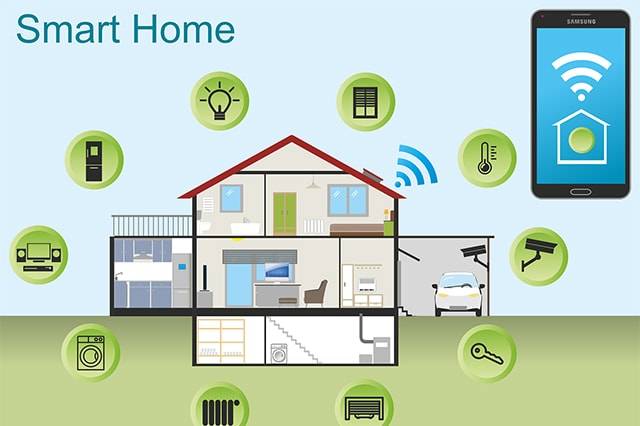Isn’t it amazing when you get up in the morning and there is a cup of steaming coffee already waiting for you? The washing machine does the laundry on specified schedules on its own. Doors automatically open and lock when they sense a person walking towards them or away from them. And all you have to do is use your phone to program your house to become a smart home.
Smart homes have been all the buzz for the past couple of years. Wireless technology and the internet is constantly evolving. It’s not surprising that people have found more than one way to automate homes so they can provide more comfort, efficiency, and security.
Aside from improved connectivity and technology, more people are becoming more concerned about rising energy costs and consumption. According to the Energy Department, heating and cooling use approximately 48% of the total energy used in one home in America. That is almost half of what one household consumes! So, if there is a system that can effectively cut down your energy consumption and spending, why wouldn’t you use it?
The benefits of a smart home are certainly many. But to fully enjoy the perks of having an automated house, you have to make sure you set up the smartest system for your property. Follow these 8 steps in order get started on the right track.
1. Do Your Homework
The smart home industry keeps on evolving. There are new products, manufacturers, programs, and protocols coming out each year, so read up on the available technology. Do you really need to change all of your appliances for new, “smarter” ones? Or, is there a program that can make your existing electronics smarter? Find out which kits and smart appliances and devices save the most energy and require the least maintenance. Read product reviews from unbiased sources as well. Smartly planning your smart home begins with knowing what is available and practical.
2. Know What You Need for Your Smart Home
With all the fancy gadgets out there today, you can get carried away in choosing smart products for your home. Ask yourself, do you really need that expensive coffee maker that makes you a cup when it detects you’re awake? Or, perhaps, your money is better spent on a voice-activated AI assistant? Determine what you want to control better within your living spaces and narrow things down from there. Lighting, thermostats, and security are the top three systems most homeowners prioritize. Others go beyond that to include appliances for the kitchen, bathroom, home entertainment, and even gadgets for gardening.
3. Set a Budget
Deciding how much your willing to spend can guide you in which smart home device to purchase. Knowing how much you can actually afford to spend keeps you focused on the essentials. Additionally, many marketers will tack on an energy-saving label on their products. Double check if, indeed, these devices can help you cut down energy costs moving forward. And don’t forget to consider maintenance costs as well.
4. Check the Rules
Those who are renting have to consult their lease contracts before planning any smart home improvements. Those of you who are staying in apartments need to consider the regulations for your buildings. If you live in your own house, you’ll have more freedom in upgrading your home. However, make sure to check local state laws about any improvements you’re planning.
5. Make Sure Your Home Is Connected
Since your devices need to communicate with each other, you need to make sure they stay connected. See to it that you have a strong and reliable Wi-Fi signal all around your property. To back that up in case your Wi-Fi network gets crammed or encounters issues, install ethernet cables across your home. Wireless may be more convenient, but wired internet is definitely more reliable.
6. Prioritize Security
One of the main reasons why most homeowners want smarter homes is to boost the security on their property. However, smart home systems rely on the internet to communicate with and control devices. So, being exposed to internet security threats is a possibility you should always keep in mind.
Experts recommend changing default logins and passwords on all of your devices, and frequently changing them too. Another tip is to select a router with a hardware firewall, and make sure the firewall is always active. It is also better to opt for branded products rather than cheaper, yet more unsecured devices.
7. Choose One Protocol
There are several home automation networks available today. These include Zigbee, Z-Wave, X10, Thread, Wi-Fi, and Bluetooth. When you find a manufacturer that you like, find out what protocol they use, then stick to this type of network when choosing future additional devices. This is because not all types of protocols can connect with each other.
8. Work with Experts
If any improvements involve electrical wiring, it’s best to let a pro do the work. This will save you from the dangers of harming yourself or your property. Plus, some building regulations in certain states require all electrical jobs to be done by a licensed electrician.

When it comes to home automation systems, it’s also wise to talk to experts. Technology can be easily accessed and learned by most people today, but smart home networks can actually be more complicated than they seem. Especially if they involve various kinds of technology like solar energy systems, pool pumps, and garden irrigation. So, if you are a home automation newbie, or are planning to install some serious high-tech systems in your pad, work with specialists.
The Future of Smart Homes
An article on LuxuryRealEstate.com predicts that most homes will have at least 50 connected devices by the year 2020. Some experts also believe that future automated homes won’t need handheld controls to work appliances. Instead, your house will make your air conditioner cooler by automatically scanning your body temperature when you walk in. You can push open window blinds with just a wave of the hand. Indeed, home automation isn’t just an exciting idea anymore from “The Jetsons” cartoon series or from sci-fi books or movies. It is a reality of our today and our future.


